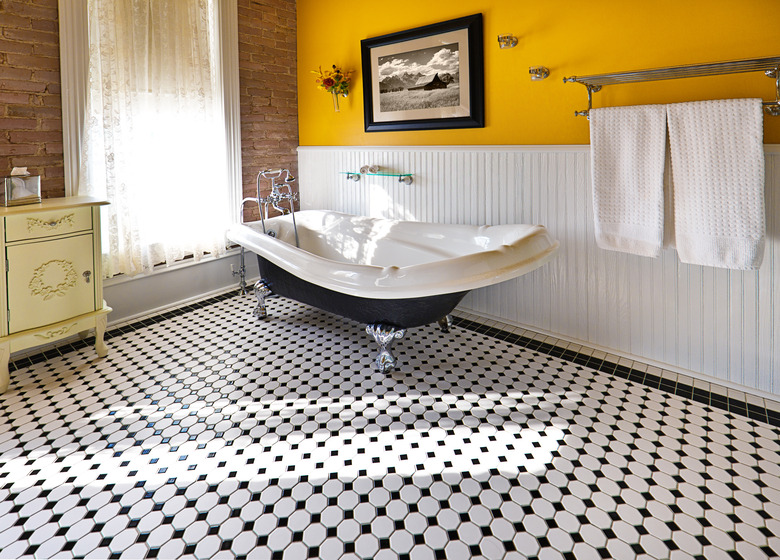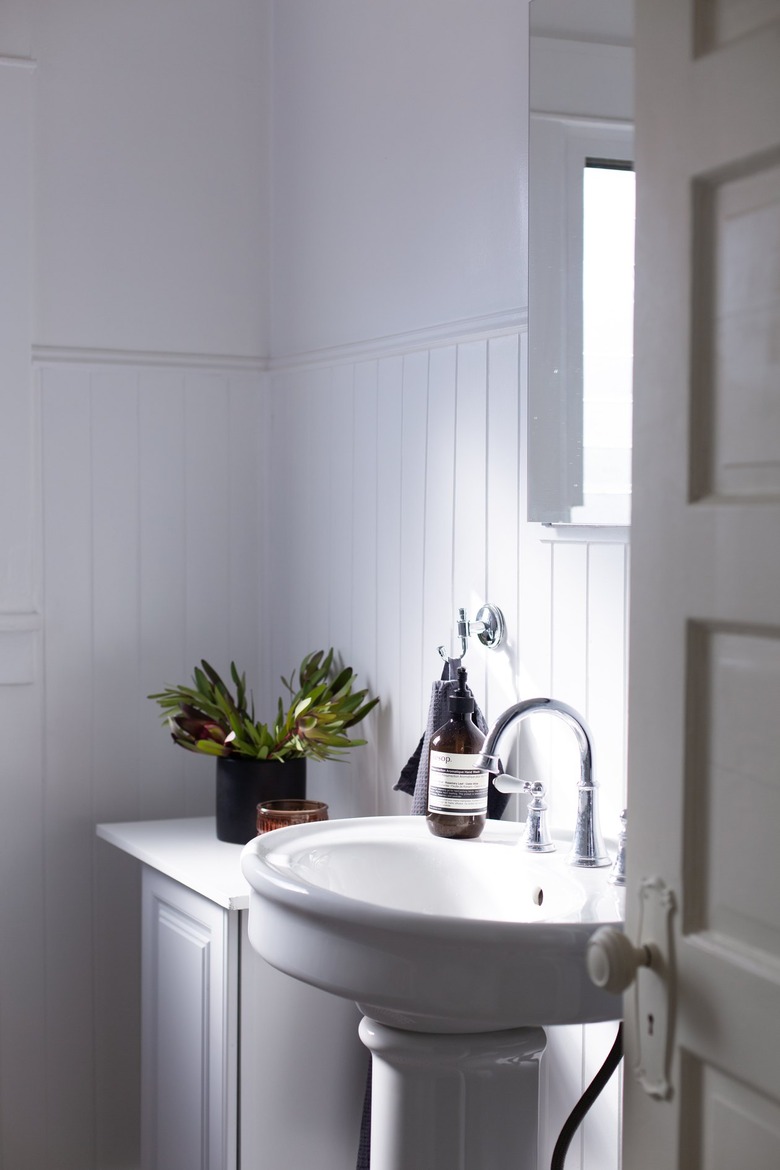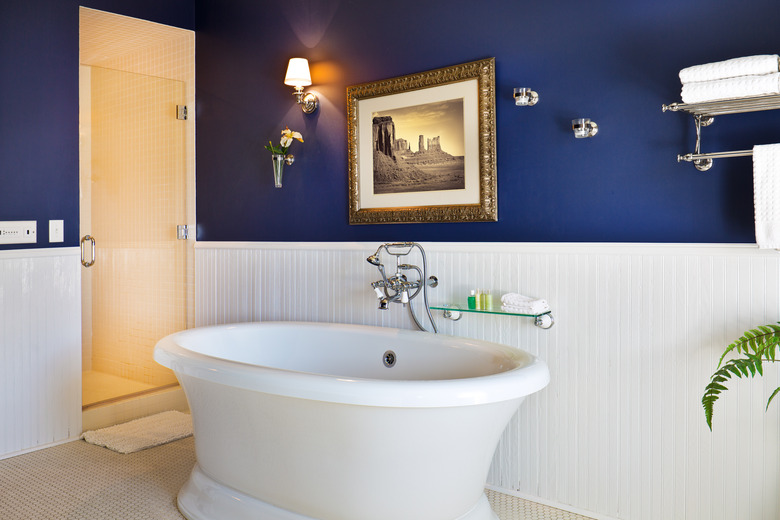How To Install Wood Wainscoting In The Bathroom
Putting wood wainscoting in the bathroom is not without its risks, considering the effects that moisture can have on wood paneling, but there are two ways to minimize potential problems. One is to use cedar, which is a rot-resistant and mildew-resistant wood species, and the other is to seal the wood with paint or a clear finish. A third option is to install beadboard wainscoting made from PVC or moisture-resistant medium-density fiberboard (MDF) or hardboard, but that option won't work if you have your heart set on real wood.
Installing wood wainscoting is a fairly simple bathroom remodel if you have the right tools at your disposal.
Wood Wainscoting Options for the Bathroom
Wood Wainscoting Options for the Bathroom
The term "wainscoting" refers to wall panels that cover the lower part of the wall, usually the lower third, although the height is optional. It usually includes trim along the upper edge known as "chair rail," and despite its name, it doesn't have to be at the height of a standard chair back. According to building and remodeling company BMC, the term is said to have originated with the Shakers, who used the rails to hang chairs that weren't in use. Designers often install the chair rail on bathroom walls at the same height as the bathroom vanity.
Plywood beadboard is one of the most common types of wood wainscoting, and it often has overlapping or tongue-and-groove edges to create smooth, unnoticeable seams. Some beadboard is constructed without interlocking edges, so each seam has to be covered by a batten, and for design purposes, you may opt to install battens even if the panels do interlock. Beadboard panels made from MDF and hardboard are milled to look like wood, and if you're planning on painting the wainscoting, you can save money by choosing these materials.
Tongue-and-groove planks made of solid cedar or redwood can also be used effectively as wainscoting, and because cedar is mold-resistant and mildew-resistant, it's one of the best materials, and while finishing it is optional, a clear sealer deepens the natural wood tones and adds visual appeal, and it makes the wood more moisture-resistant and washable. Leaving cedar paneling unfinished is more appropriate for a powder room that has no shower or bathtub and cleaning needs are minimal.
Wood Wainscoting Installation: An Overview
Wood Wainscoting Installation: An Overview
Installing wood wainscoting in the bathroom is a DIY home improvement project that requires basic carpentry skills, and because the job is easier if you remove the toilet and possibly the sink plumbing, it requires a few plumbing skills as well. If you have a pedestal or wall-mount sink, you'll have to remove the plumbing shutoff valves so you can fit the panels tightly around the water pipes, which are visible.
You might also have to do some very basic electrical work because when you notch the paneling around receptacle boxes, you may have to extend the boxes out to bring them flush with the new wall (this is a code requirement to prevent a fire hazard). Fortunately, you can purchase electrical box extenders that make this a simple job.
The work of installing the panels can usually be accomplished with a few basic carpentry tools, including saws, measuring tools and a brad nailer. The bottom edges of the panels or planks can sit on top of the baseboards if desired. If so, the baseboards should be installed first, says Extreme How-To, so you can use it as a reference for measuring and cutting the panels. Alternatively, you can install the wainscoting and add the baseboards over the paneling; this option is preferable when the top edge of the baseboard is not thicker than the paneling.
After installing plank or panel wainscoting and the chair rail or other decorative trim, the final step before replacing the plumbing fixtures is to caulk the chair rail, the baseboard and the edges of any battens you install.
Finish Options for Wood Wainscoting
Finish Options for Wood Wainscoting
You can paint wood wainscoting, of course, and if you do, any latex-based interior enamel will work. Wood paneling and planks should be sealed with a high-solids primer, which seals knots and prevents them from bleeding through the paint and helps guarantee paint adhesion and a smooth overall finish.
If you want a clear finish, the best choice for a bathroom is spar varnish because it provides the best moisture protection of any clear finish. Spar varnish may change the color of the wood somewhat, so if that's a concern, use polyurethane. Deft interior/ exterior water-based polyurethane is a top-rated product that won't yellow and cleans up with soap and water.
How to Install Wood Wainscoting in the Bathroom
1. Clear Out the Bathroom
Remove the toilet and, if possible, the sink and the bathroom vanity. Take all the covers off the electrical boxes around which you will be installing the wainscoting and remove anything else from the walls that will get in the way.
2. Install the Baseboards if Necessary
If the bathroom doesn't already have baseboards, install them now. If you want to avoid having to cut the paneling at an angle, use a spirit level to level the baseboards. You can fill the gaps between the baseboards and the floor with caulk at the end of the installation.
3. Mark the Position of the Top of the Paneling
Use a tape measure and pencil to mark the top of the paneling on one of the walls and then draw a level line around the room at this height. This line will be hidden by the chair rail, so don't forget to add the width of the rail when calculating the final height.
4. Prep the Wall
Make any necessary drywall repairs. If the wall has a texture, it's a good idea to scrape or sand it off to ensure glue adhesion. Using a sponge and rubber gloves, wash the walls between the baseboard and the panel-height line with a deglossing solution made with 1/2 cup of trisodium phosphate per gallon of water, following the manufacturer's directions.
5. Mark the Stud Positions
Locate the wall studs using a stud finder and denote the position of each with light marks (indicating both sides of each stud) just above the panel-height line. When you drive nails to hold the panels while the adhesive sets, they should go in a line on a stud.
6. Install the Panels
Dry-fit the wainscoting on one wall or a section of a wall and cut panels to fit, as needed. Cut notches for electrical boxes, pipes and other obstructions with a jigsaw. Spread construction adhesive on the back of each panel, press it to the wall, interlock it with the previous panel and, using a brad nailer, drive brads into the studs to hold it.
Tip
You can glue wainscoting to tile walls, but since you can't drive nails, you may need to construct some T-braces with 2x4 lumber to hold them while the glue sets. Make the braces long enough to extend across the bathroom so you can wedge them against the opposite wall.
7. Install the Trim
Depending on the style you choose, the chair rail may fit over the edge of the paneling, or you may need to install a furring strip and attach the trim to the strip. Nail the furring strip and the trim to the studs with brads or finish nails.
When installing battens, it's best to space them to be in front of studs wherever possible so you can nail them securely. If you can't do this, glue the battens to the paneling with construction adhesive.
8. Paint or Finish With Clear Finish
Sand the paneling lightly before applying the first coat of paint or clear finish. When painting, apply primer first followed by two coats of paint. For a clear finish, apply at least two coats according to the manufacturer's directions.
9. Caulk the Trim
Use silicone caulk with a color that matches the trim, or use clear silicone. Apply the caulk to both edges of the chair rail, battens, and baseboards. Also caulk along any existing trim against which the panels abut and in the corners of the bathroom where the paneling isn't trimmed.


